The demand for electricity is increased due to the development of the industry, the electrification of transport, the rise of household demand, and the increase in demand for digitally connected devices and air conditioning systems. For that, solutions and actions should be developed for greater consumers of electricity. For instance, MG (Micro-grid) buildings are one of the main consumers of electricity, and if they are correctly constructed, controlled, and operated, significant energy savings can be attained. As a solution, hybrid RES (renewable energy source) systems are proposed, offering the possibility for simple consumers to be producers of electricity. This hybrid system contains different renewable generators connected to energy storage systems, making it possible to locally produce a part of energy in order to minimize the consumption from the utility grid.
- control approaches
- Energy management
- Micro-grid systems
- predictive control
1. Introduction
2. Control Architectures
Table 1.
| Ref. | Grid | DG | PV | WT | Biomass | |
|---|---|---|---|---|---|---|
| MG Scale | Control Structure | |||||
| FC | Hydrogen | Battery | Diesel | Super-Capacitor | EV | Performance Evaluation |
| [2] | ✓ | ✓ | ✓ | ✓ | ✓ |
| [3] | A methodology for modeling and optimally sizing a hybrid system for renewable energy considering two energy storage devices: Hydrogen and batteries. | |||||||||||
| The Multi-Objective Particle Swarm Optimization algorithm is used to improve electric energy utilization in remote areas. Simulation results are presented. | ||||||||||||
| Wavelet transform, Neural network and Fuzzy logic (FL) | Large | Not specified | ||||||||||
| [3] | ✓ | ✓ | ✓ | ✓ | The development of a methodology for modeling and optimally sizing a hybrid system of RESs and two energy storage devices (hydrogen and batteries). Simulation results are presented. | |||||||
| [ | ||||||||||||
| 19 | ||||||||||||
| ] | ||||||||||||
| A model predictive control technique to determine the optimal operation of the MG system using an extended horizon of evaluation and recourse. The EM problem is decomposed into Unit Commitment and Optimal Power Flow problems in order to avoid a mixed-integer non-linear formulation. | Model predictive control | Large | Centralized | |||||||||
| [20] | Authors present an EM system to minimize the daily operating cost of a MG and maximize the self-consumption of the deployed RES by selecting the best setting for a central battery storage system based on a defined cost function. | Convex Programming, Model Predictive, and Rolling Horizon | Medium | Hierarchical | ||||||||
| [21] | The operating cost of MG is minimized, while considering droop controlled active and reactive power dispatch of AC side MG as a constraint. | Mixed integer nonlinear programming |
Small | Centralized |

2.1. Centralized Control
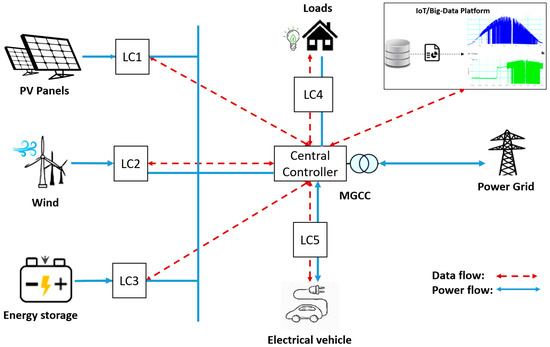
Figure 2.
Numerous research works have developed and deployed centralized EM strategies. For instance, the authors of [22] proposed a centralized controller in order to optimize the operation of MG by maximizing the production of distributed RESs generators while establishing back-and-forth energy transfer with the main utility grid. The efficiency of the proposed solution on the MG system was investigated by considering a typical case network operating under various market policies and spot market prices. Moreover, the authors of[19] developed a centralized EM system for a standalone MG system based on the model predictive control method in order to reduce the computational loads. In fact, the studied problem was solved iteratively by nonlinear programming (NLP) and mixed-integer linear programming (MILP) techniques. Other centralized control strategies are summarized in
Table 2. However, despite the ease of implementing the centralized strategies, they have shown their limits, especially when dealing with large-scale hybrid systems[23].
2.2. Decentralized Control
Unlike centralized strategies, in decentralized control, each entity is considered autonomous using an LC. This means that groups of entities are controlled separately by a leader. In literature, the terms ‘decentralized’ and ‘distributed controls’ are often used in place of each other[24][25]. The distributed control can be considered as a decentralized control in which LCs use local measurements, such as frequency and voltage values, to elect the leader entity. They are also allowed to share information with neighbors. For a distributed control, LCs do not only use local measurements but also are able to send and receive required information to other LCs[26]. In decentralized control approaches, limited local connections are required and the control decisions are made based only on local measurements (
Figure 3). It does not require a high-performance computing unit and high-level connectivity[27].
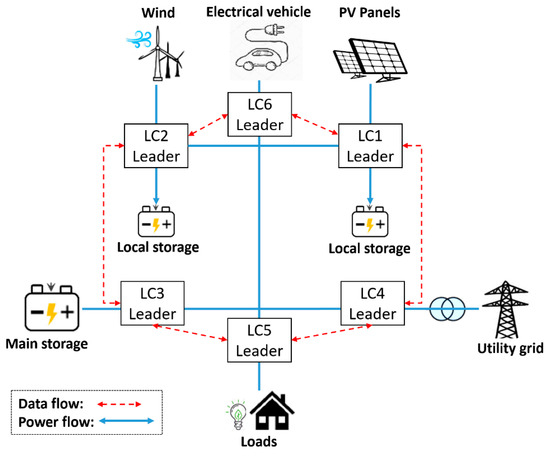
Figure 3.
However, monitoring, processing, and data visualization are considered critical in order to coordinate various distributed controllers and achieve a global operation goal. This process is standardized by the norm IEC-61968 for a single-building energy management system and by IEC-61850 for interoperability between building MG systems[28][29][30]. Depending on the communication network availability, the decentralized control can be classified into three operation modes: (i) Fully dependent, in which the distributed controllers generate local control decision while communicating information with each other via a CC; (ii) partially independent, in which LCs communicate with each other and share information with the CC in order to generate central decisions; and (iii) fully independent, in which the distributed controllers communicate directly with each other and independently from the CC[31]. However, despite the flexibility of these operational modes, the decentralized control structure presents low performance compared to centralized control [32][33][34]. This is due to the low response time and incomplete information about the total MG system installation.
2.3. Hierarchical Control
Hierarchical control is mainly proposed for SG (smart grid) systems. In fact, the extended geographic areas of these systems and the extensive communication and computation requirements make the implementation of fully centralized approaches a difficult task. At the same time, the higher coupling between the different LCs requires a maximum level of coordination, which cannot be achieved by decentralized control structures. However, a compromise between the fully centralized and decentralized control structures is realized by providing hierarchical control structures[35][36] according to three control levels: Primary, secondary, and tertiary, as depicted in
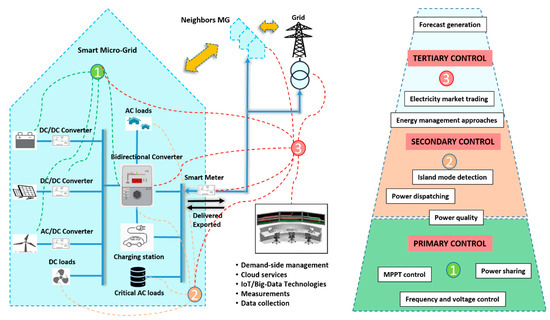
Figure 4.
The primary control level stabilizes the voltage and frequency generated from each source in order to respect the limits required by the standards
[371][38][39]. In addition, the primary control level detects the operating mode of MG systems, offering the ability to operate in grid-connected and standalone modes [40]. For the secondary control level, the MG voltage and frequency are restored after the system’s load variation. The aim is to ensure and enhance the power quality within the required standards values, allowing the synchronization between the MG systems and the main electrical network [41].
The main objectives of tertiary control are the power flow control in the grid-connected mode, ensuring then the optimal operation in both modes like capacitance and inductance[42].
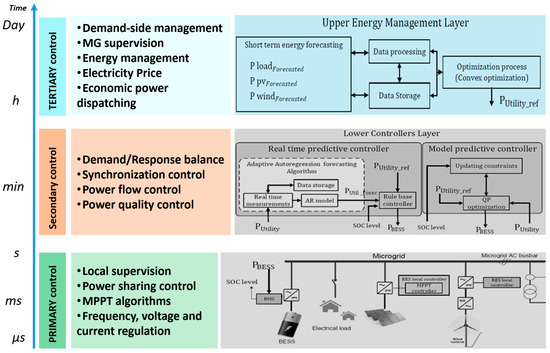
Figure 5.
Table 3.
| EM | Advantages | Inconveniences | ||||||||||||
|---|---|---|---|---|---|---|---|---|---|---|---|---|---|---|
| Centralized |
|
|
||||||||||||
| Decentralized |
|
|
[4] | ✓ | ✓ | ✓ | ✓ | ✓ | ||||||
| [4] | A method is developed to size an off-grid PV/diesel/FC hybrid energy system in order to optimize the number of system components with respect to the cost minimization of the installation. | Crow search algorithm | Large | |||||||||||
| Hierarchical | ||||||||||||||
| The Crow search algorithm is used to optimize and size a hybrid system. Two constraints are considered to minimize the total net cost: Loss of power supply probability and renewable energy portion. Simulation results are presented. | |||||||||||||
| [8] | An EM method is deployed in a MG system containing energy storage devices and renewable energy based distributed generators in grid-connected MG. In the studied approach, the neighboring MG share the capacity of their distributed resources and energy storage devices aiming at reducing the operational costs. | |||||||||||||
| Hierarchical |
| |||||||||||||
| Lexicographic programming, Linear programming, Receding horizon control | ||||||||||||||
|
| |||||||||||||
| Large | ||||||||||||||
| ||||||||||||||
| Hierarchical | ||||||||||||||
|
[5] | |||||||||||||
| ||||||||||||||
| [ | ||||||||||||||
| ✓ | ✓ | ✓ | ||||||||||||
| 9 | ||||||||||||||
| ] | A deterministic constrained optimization and stochastic optimization approaches to estimate the uncertainties in biomass-integrated MG supplying both heat and electricity. The work developed an economic linear programming model with a sliding time window to assess design, scheduling of biomass-combined power and heat-based MG systems. | Linear programming model with a sliding time window | ||||||||||||
| ✓ | The operation of a grid-connected hybrid PV-wind system is performed using a standalone inverter capable of working in grid-connection mode and standalone mode. Experimental investigations are presented. | |||||||||||||
| Small | Decentralized | |||||||||||||
| [6] | ||||||||||||||
| [ | ||||||||||||||
| 10] | A MG energy management strategy by considering RES integration into the distribution network. The time-of-use, other technical constraints, and an enhanced bee colony optimization is proposed to solve the daily economic dispatch of MG systems. | Enhanced bee colony optimization | Small | |||||||||||
| ✓ | ||||||||||||||
| Centralized | ||||||||||||||
| ✓ | ✓ | The work proposed a real-time EM control strategy combining wavelet transform, neural network, and fuzzy logic methods. Experimental results exposed that the power variation and the peak power of the battery pack have been successfully suppressed. | ||||||||||||
| [7] | ||||||||||||||
| [ | ||||||||||||||
| 11 | ||||||||||||||
| ] | ||||||||||||||
| ✓ | ✓ | ✓ | ✓ | An intelligent control strategy is developed for a hybrid energy storage system, composed of fuel cell, battery, and super capacitor. Multi-input/multi-output state-space model is used to perform the study. Simulation results are presented. | ||||||||||
| Authors proposed a combined EM and sizing methodology, formulated as a leader follower problem. The leader problem focuses on sizing and aims at selecting the optimal size for the MG components. The problem is solved using a genetic algorithm and the follower problem is formulated as a unit commitment problem and is solved with a mixed integer linear program. | Mixed integer linear program | Small | Centralized | |||||||||||
| [8] | ✓ | ✓ | ✓ | ✓ | ✓ | |||||||||
| [ | ||||||||||||||
| 14] | Authors proposed an EM approach to divert excess energy of PV to the electrolyzer. | Linear Programming | Small | |||||||||||
| A multi-objective optimization problem, over a receding control horizon, is used for energy storage dispatch and sharing of renewable energy resources in a network of grid-connected MG. The multi-objective optimization is formulated as a lexicographic program to allow preferential treatment of multiple MG. Simulation results are presented. | ||||||||||||||
| Centralized | ||||||||||||||
| [9] | ✓ | ✓ | ✓ | ✓ | ✓ | |||||||||
| [ | ||||||||||||||
| ✓ | ||||||||||||||
| 15] | An analysis of energy management system of a MG using a robust optimization taking the uncertainties of wind power and solar power generations and energy consumption into consideration. | Agent-based modelling | Large | |||||||||||
| An economic linear programming model is developed with a sliding-time-window to assess design and scheduling of biomass, combined heat and power-based MG systems. Simulation results are presented. | ||||||||||||||
| Decentralized | ||||||||||||||
| [10] | ✓ | ✓ | ✓ | ✓ | Distribution network including RESs is studied for optimal dispatch model of mixed-power generation by considering the charging/discharging scheduling of battery. Bee-colony-optimization method is proposed to solve the daily economic dispatch of MG systems. Simulation results are presented. | |||||||||
| [16] | An algorithm for EM system of a MG using multi-layer ant colony approach pointing on determining the optimum point of operation for local distributed energy generation with least electricity production cost. The studied algorithm has the capability of analyzing the constraints related to economic and technical aspects of the problem. | Multi-layer ant colony approach | Medium | |||||||||||
| ✓ | ||||||||||||||
| Not specified | ||||||||||||||
| [11] | ✓ | |||||||||||||
| [ | ||||||||||||||
| 17 | ||||||||||||||
| ✓ | ||||||||||||||
| ] | ||||||||||||||
| ✓ | ✓ | |||||||||||||
| A method known as contingency-based energy management for a system of MGs. A stochastic optimization is proposed according to various scenarios of the contingencies. | ||||||||||||||
| A combined sizing and EM methodology is proposed and formulated as a leader-follower problem. The leader problem focuses on sizing and aims at selecting the optimal size for the MG components. It is solved using a genetic algorithm. Simulation results are presented. | ||||||||||||||
| Contingency-based energy management | Large | Hierarchical | ||||||||||||
| [12] | ||||||||||||||
| [18] | ||||||||||||||
| ✓ | ||||||||||||||
| A fuzzy EM approach is deployed to smooth the power flow of a MG containing heat and power unit. The aims is to use the surplus of electrical power of the MG for storing in electrical energy storage systems and ensuring the water temperature of the thermal storage system in the desired value in order to supply residential buildings. | Fuzzy energy management strategy | |||||||||||||
| ✓ | ✓ | ✓ | A strategy for the optimal management of a multi-good standalone MG integrated with RES is investigated. The proposed approach is defined through an EM model able to determine the schedule of each programmable unit to fulfil the community needs at the lowest operation cost. Simulation results are presented. | |||||||||||
| Medium | Not specified | |||||||||||||
| [13] | ✓ | ✓ | ✓ | ✓ | ✓ | ✓ | ✓ | Electrical vehicles are used for peak shaving and load curve correction in a MG system. The deployed methods deal with the simultaneous scheduling of electrical vehicles and reactive loads in order to minimize operation cost and emission in presence of RES in MG system. Simulation results are presented. | ||||||
| [14] | ✓ | ✓ | ✓ | ✓ | A power management system is presented to manage the power output from RES, fuel cell, and batteries with delivery of hydrogen from an electrolyzer. The deployed strategy handles the source effectively by considering the limited lifecycle of storage devices. It eliminates the need for a dump load in the MG when the storage devices are charged to the maximum capacity. Simulation results are presented. |
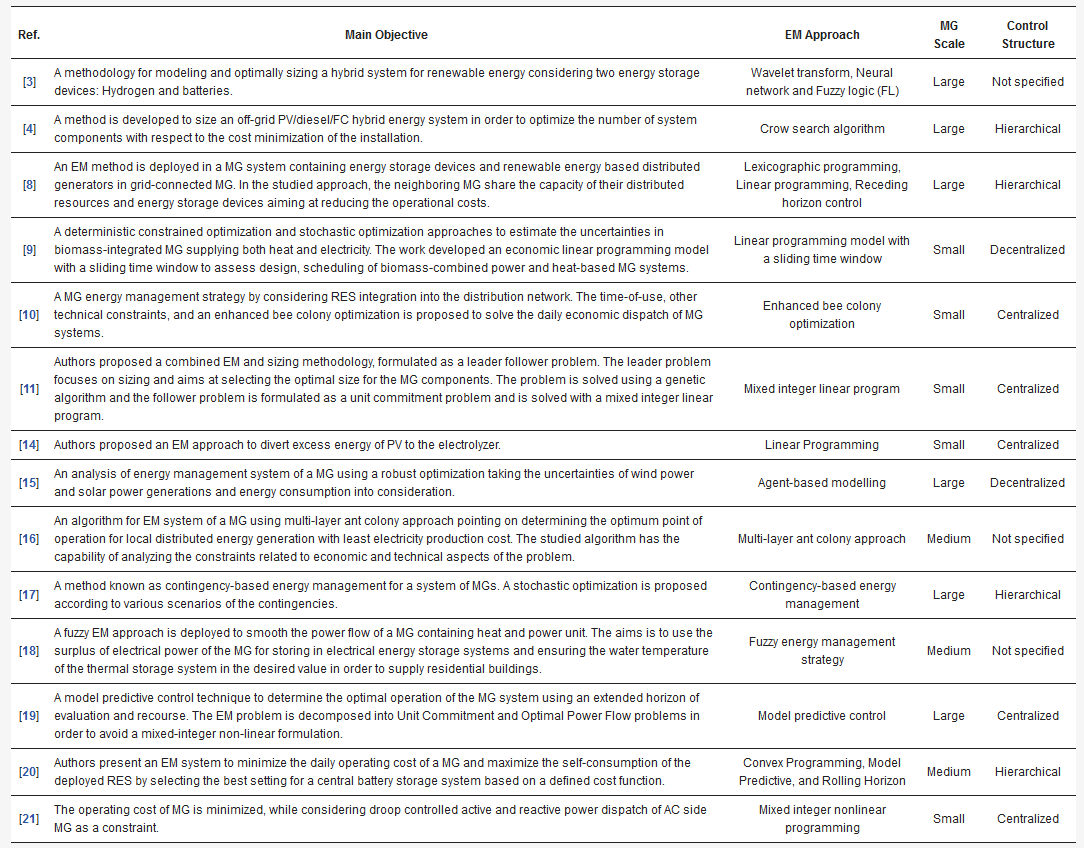

Figure 1.
Table 2.
| Ref. | Main Objective | EM Approach |
|---|
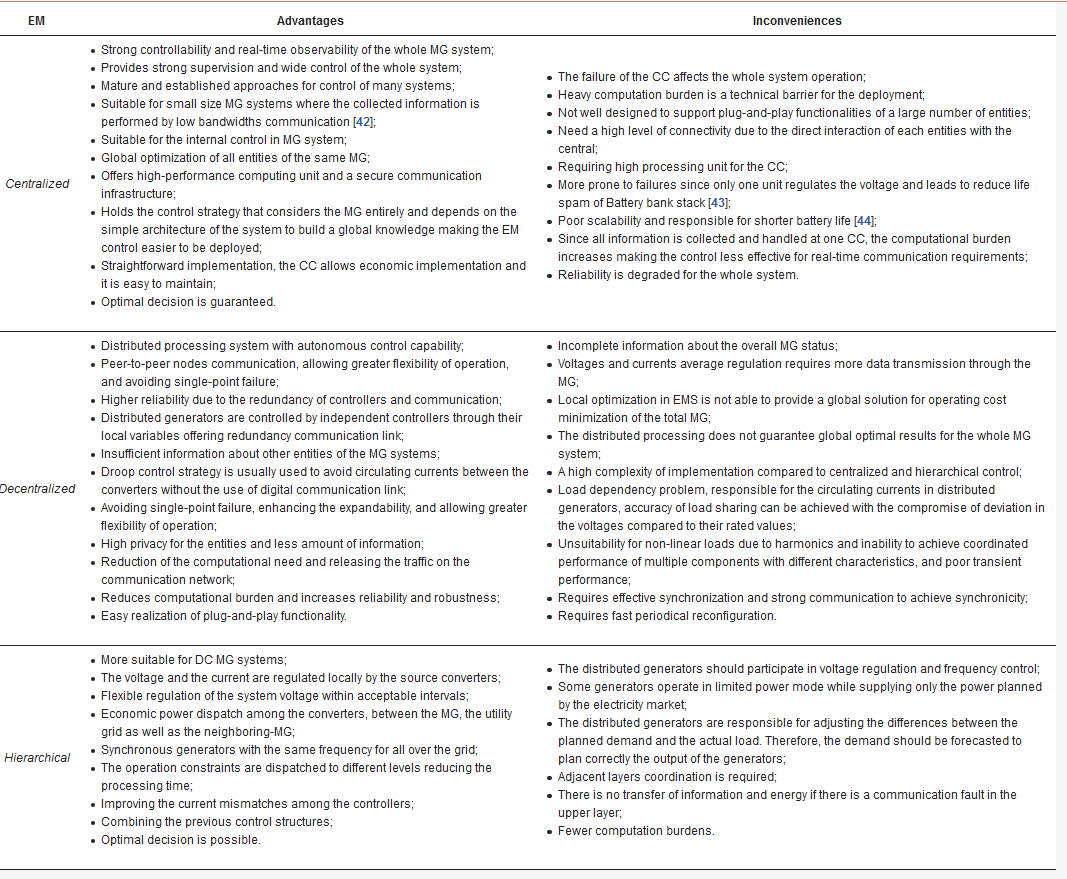
References
- Higuita Cano, M. Système de gestion de l’énergie basé sur l’incertitude pour un système hybride à sources d’énergie renouvelable autonome avec production d’hydrogène. Ph.D. Thesis, Université du Québec à Trois-Rivières, Quebec, QC, CA, 2017.Abdellatif Elmouatamid; Radouane Ouladsine; Mohamed Bakhouya; Najib El Kamoun; Mohammed Khaidar; Khalid Zine-Dine; Review of Control and Energy Management Approaches in Micro-Grid Systems. Energies 2020, 14, 168, 10.3390/en14010168.
- Indragandhi, V.; Logesh, R.; Subramaniyaswamy, V.; Vijayakumar, V.; Siarry, P.; Uden, L. Multi-objective optimization and energy management in renewable based AC/DC microgrid. Comput. Electr. Eng. 2018, 70, 179–198, doi:10.1016/j.compeleceng.2018.01.023.
- Zhang, W.; Maleki, A.; Rosen, M.A.; Liu, J. Optimization with a simulated annealing algorithm of a hybrid system for renewable energy including battery and hydrogen storage. Energy 2018, 163, 191–207, doi:10.1016/j.energy.2018.08.112.
- Ghaffari, A.; Askarzadeh, A. Design optimization of a hybrid system subject to reliability level and renewable energy penetration. Energy 2020, 193, 116754, doi:10.1016/j.energy.2019.116754.
- Dali, M.; Belhadj, J.; Roboam, X. Hybrid solar-wind system with battery storage operating in grid-connected and standalone mode: Control and energy management—Experimental investigation. Energy 2010, 35, 2587–2595, doi:10.1016/j.energy.2010.03.005.
- Zhang, Q.; Wang, L.; Li, G.; Liu, Y. A real-time energy management control strategy for battery and supercapacitor hybrid energy storage systems of pure electric vehicles. J. Energy Storage 2020, 31, 101721, doi:10.1016/j.est.2020.101721.
- Sai Chandan, R.; Sai Kiran, T.L.; Swapna, G.; Vijay Muni, T. Intelligent Control Strategy for Energy Management System with Fc/Battery/Sc. J. Crit. Rev. 2020, 7, 344–348, doi:10.31838/jcr.07.02.66.
- Sandgani, M.R.; Sirouspour, S. Priority-Based Microgrid Energy Management in a Network Environment. IEEE Trans. Sustain. Energy 2018, 9, 980–990, doi:10.1109/tste.2017.2769558.
- Zheng, Y.; Jenkins, B.M.; Kornbluth, K.; Træholt, C. Optimization under uncertainty of a biomass-integrated renewable energy microgrid with energy storage. Renew. Energy 2018, 123, 204–217, doi:10.1016/j.renene.2018.01.120.
- Lin, W.-M.; Tu, C.-S.; Tsai, M.-T. Energy Management Strategy for Microgrids by Using Enhanced Bee Colony Optimization. Energies 2015, 9, 5, doi:10.3390/en9010005.
- Li, B.; Roche, R.; Miraoui, A. Microgrid sizing with combined evolutionary algorithm and MILP unit commitment. Appl. Energy 2017, 188, 547–562, doi:10.1016/j.apenergy.2016.12.038.
- Mazzola, S.; Astolfi, M.; Macchi, E. A detailed model for the optimal management of a multigood microgrid. Appl. Energy 2015, 154, 862–873, doi:10.1016/j.apenergy.2015.05.078.
- Rabiee, A.; Sadeghi, M.; Aghaeic, J.; Heidari, A. Optimal operation of microgrids through simultaneous scheduling of electrical vehicles and responsive loads considering wind and PV units uncertainties. Renew. Sustain. Energy Rev. 2016, 57, 721–739, doi:10.1016/j.rser.2015.12.041.
- Dash, V.; Bajpai, P. Power management control strategy for a stand-alone solar photovoltaic-fuel cell-
- Dash, V.; Bajpai, P. Power management control strategy for a stand-alone solar photovoltaic-fuel cell-battery hybrid system. Sustain. Energy Technol. Assess. 2015, 9, 68–80, doi:10.1016/j.seta.2014.10.001.
- Kuznetsova, E.; Ruiz, C.; Li, Y.-F.; Zio, E. Analysis of robust optimization for decentralized microgrid energy management under uncertainty. Int. J. Electr. Power Energy Syst. 2015, 64, 815–832, doi:10.1016/j.ijepes.2014.07.064.
- Marzband, M.; Yousefnejad, E.; Sumper, A.; Domínguez-García, J.L. Real time experimental implementation of optimum energy management system in standalone Microgrid by using multi-layer ant colony optimization. Int. J. Electr. Power Energy Syst. 2016, 75, 265–274, doi:10.1016/j.ijepes.2015.09.010.
- Aghdam, F.H.; Salehi, J.; Ghaemi, S. Contingency based energy management of multi-microgrid based distribution network. Sustain. Cities Soc. 2018, 41, 265–274, doi:10.1016/j.scs.2018.05.019.
- Arcos-Aviles, D.; Sotomayor, D.; Proaño, J.L.; Guinjoan, F.; Marietta, M.P.; Pascual, J.; Marroyo, L.; Sanchis, P. Fuzzy energy management strategy based on microgrid energy rate-of-change applied to an electro-thermal residential microgrid. In Proceedings of the 2017 IEEE 26th International Symposium on Industrial Electronics (ISIE), Edinburgh, UK, 19–21 June 2017; Institute of Electrical and Electronics Engineers (IEEE): New Jersey, NJ, USA, 2017; pp. 99–105.
- Olivares, D.E.; Canizares, C.A.; Kazerani, M. A Centralized Energy Management System for Isolated Microgrids. IEEE Trans. Smart Grid 2014, 5, 1864–1875, doi:10.1109/tsg.2013.2294187.
- Elkazaz, M.; Sumner, M.; Thomas, D. Energy management system for hybrid PV-wind-battery microgrid using convex programming, model predictive and rolling horizon predictive control with experimental validation. Int. J. Electr. Power Energy Syst. 2020, 115, 105483, doi:10.1016/j.ijepes.2019.105483.
- Helal, S.A.; Najee, R.J.; Hanna, M.O.; Shaaban, M.F.; Osman, A.H.; Hassan, M.S. An energy management system for hybrid microgrids in remote communities. In Proceedings of the 2017 IEEE 30th Canadian Conference on Electrical and Computer Engineering (CCECE), Windsor, ON, CA, 30 April–3 May 2017; Institute of Electrical and Electronics Engineers (IEEE): New Jersey, NJ, USA, 2017; pp. 1–4.
- Tsikalakis, A.G.; Hatziargyriou, N.D. Centralized control for optimizing microgrids operation. In Proceedings of the 2011 IEEE Power and Energy Society General Meeting, Detroit, MI, USA, 24–28 July 2011; Institute of Electrical and Electronics Engineers (IEEE): New Jersey, NJ, USA, 2011; pp. 1–8.
- Warnier, M.; Dulman, S.; Koç, Y.; Pauwels, E. Distributed monitoring for the prevention of cascading failures in operational power grids. Int. J. Crit. Infrastruct. Prot. 2017, 17, 15–27, doi:10.1016/j.ijcip.2017.03.003.
- Kermani, M.; Carnì, D.L.; Rotondo, S.; Paolillo, A.; Manzo, F.; Martirano, L. A Nearly Zero-Energy Microgrid Testbed Laboratory: Centralized Control Strategy Based on SCADA System. Energies 2020, 13, 2106, doi:10.3390/en13082106.
- Yamashita, D.Y.; Vechiu, I.; Gaubert, J.-P. A review of hierarchical control for building microgrids. Renew. Sustain. Energy Rev. 2020, 118, 109523, doi:10.1016/j.rser.2019.109523.
- Pourbabak, H.; Chen, T.; Su, W. Centralized, decentralized, and distributed control for Energy Internet. In The Energy Internet; Elsevier BV: Amsterdam, The Netherlands, 2019; pp. 3–19.
- Senjyu, T.; Kuninaka, R.; Urasaki, N.; Fujita, H.; Funabashi, T. Power system stabilization based on robust centralized and decentralized controllers. In Proceedings of the 2005 International Power Engineering Conference, Singapore, 29 November–2 December 2005; Institute of Electrical and Electronics Engineers (IEEE): New Jersey, NJ, USA, 2006; pp. 905–910.
- Liu, C.C.; McArthur, S.; Lee, S.J. Smart Grid Handbook, 3 Volume Set; John Wiley & Sons: New Jersey, NJ, USA, 2016.
- Aftab, M.A.; Hussain, S.M.S.; Ali, I. ICT Technologies, Standards and Protocols for Active Distribution Network Automation and Management. In Advanced Communication and Control Methods for Future Smartgrids; IntechOpen: London, UK, 2019.
- Celik, B.; Roche, R.; Suryanarayanan, S.; Bouquain, D.; Miraoui, A. Electric energy management in residential areas through coordination of multiple smart homes. Renew. Sustain. Energy Rev. 2017, 80, 260–275, doi:10.1016/j.rser.2017.05.118.
- Feng, X.; Shekhar, A.; Yang, F.; Hebner, R.E.; Bauer, P. Comparison of Hierarchical Control and Distributed Control for Microgrid. Electr. Power Compon. Syst. 2017, 45, 1043–1056, doi:10.1080/15325008.2017.1318982.
- Rathor, S.K.; Saxena, D. Energy management system for smart grid: An overview and key issues. Int. J. Energy Res. 2020, 44, 4067–4109, doi:10.1002/er.4883.
- Espín-Sarzosa, D.; Palma-Behnke, R.; Núñez-Mata, O. Energy Management Systems for Microgrids: Main Existing Trends in Centralized Control Architectures. Energies 2020, 13, 547, doi:10.3390/en13030547.
- Molzahn, D.K.; Dorfler, F.; Sandberg, H.; Low, S.H.; Chakrabarti, S.; Baldick, R.; Lavaei, J. A Survey of Distributed Optimization and Control Algorithms for Electric Power Systems. IEEE Trans. Smart Grid 2017, 8, 2941–2962, doi:10.1109/tsg.2017.2720471.
- Van Nam, D.; Sualeh, M.; Kim, D.; Kim, G.-W. A Hierarchical Control System for Autonomous Driving towards Urban Challenges. Appl. Sci. 2020, 10, 3543, doi:10.3390/app10103543.
- Elmouatamid, A.; NaitMalek, Y.; Ouladsine, R.; Bakhouya, M.; Elkamoun, N.; Khaidar, M.; Zine-Dine, K. A Micro-Grid System Infrastructure Implementing IoT/Big-Data Technologies for Efficient Energy Management in Buildings. Submitted to ATSPES’1 (Advanced Technologies for Solar Photovoltaics Energy Systems); Springer, Berlin/Heidelberg, Germany, 2020.
- Elmouatamid, A. MAPCAST: An Adaptive Control Approach using Predictive Analytics for Energy Balance in Micro-Grid Systems. Int. J. Renew. Energy Res. (IJRER) 2020, 10, 945–954.
- Prabaharan, N.; Jerin, A.R.A.; Najafi, E.; Palanisamy, K. An overview of control techniques and technical challenge for inverters in micro grid. In Hybrid-Renewable Energy Systems in Microgrids; Elsevier BV: Amsterdam, The Netherlands, 2018; pp. 97–107.
- Gaiceanu, M.; Arama, I.N.; Ghenea, I. DC Microgrid Control. In Power Systems; Springer Science and Business Media LLC: Berlin/Heidelberg, Germany, 2019; pp. 357–380.
- González-Romera, E.; Romero-Cadaval, E.; Roncero-Clemente, C.; Ruiz-Cortés, M.; Barrero-González, F.; Milanés-Montero, M.-I.; Muñoz, A.M. Secondary Control for Storage Power Converters in Isolated Nanogrids to Allow Peer-to-Peer Power Sharing. Electronics 2020, 9, 140, doi:10.3390/electronics9010140.
- Guerrero, J.M.; Chandorkar, M.; Lee, T.-L.; Loh, P.C. Advanced Control Architectures for Intelligent Microgrids—Part I: Decentralized and Hierarchical Control. IEEE Trans. Ind. Electron. 2013, 60, 1254–1262, doi:10.1109/tie.2012.2194969.
- Sahoo, S.K.; Sinha, A.K.; Kishore, N.K. Control Techniques in AC, DC, and Hybrid AC-DC Microgrid: A Review. IEEE J. Emerg. Sel. Top. Power Electron. 2018, 6, 738–759, doi:10.1109/jestpe.2017.2786588.
- Kumar, J.; Agarwal, A.; Agarwal, V. A review on overall control of DC microgrids. J. Energy Storage 2019, 21, 113–138, doi:10.1016/j.est.2018.11.013.
- Cupelli, M.; Monti, A.; De Din, E.; Sulligoi, G. Case study of voltage control for MVDC microgrids with constant power loads—Comparison between centralized and decentralized control strategies. In Proceedings of the 2016 18th Mediterranean Electrotechnical Conference (MELECON), Lemesos, Cyprus, 18–20 April 2016; Institute of Electrical and Electronics Engineers (IEEE): New Jersey, NJ, USA, 2016; pp. 1–6.
- Cupelli, M.; Monti, A.; De Din, E.; Sulligoi, G. Case study of voltage control for MVDC microgrids with constant power loads—Comparison between centralized and decentralized control strategies. In Proceedings of the 2016 18th Mediterranean Electrotechnical Conference (MELECON), Lemesos, Cyprus, 18–20 April 2016; Institute of Electrical and Electronics Engineers (IEEE): New Jersey, NJ, USA, 2016; pp. 1–6.
